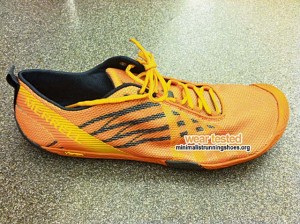 A relatively small group of individuals actually practice true barefoot running, which is running without shoes at all. Minimalist footwear, or barefoot-style shoes (for basic protection from sharp and hazardous materials), have become increasingly popular among runners. However, the question still remains, can you reduce your chance of running related injuries by switching to minimalist shoes, or do you just develop different types of injuries?
A relatively small group of individuals actually practice true barefoot running, which is running without shoes at all. Minimalist footwear, or barefoot-style shoes (for basic protection from sharp and hazardous materials), have become increasingly popular among runners. However, the question still remains, can you reduce your chance of running related injuries by switching to minimalist shoes, or do you just develop different types of injuries?
The running shoe industry is a multimillion dollar industry. Despite all the advances in running shoe technology, injuries among runners still remains high, with about 50 percent of runners likely to be injured in a given year.
True barefoot runners tend to strike the ground on their forefoot (front of foot) or mid foot (further back toward the arch), causing the runner to take softer, shorter strides. The majority of runners in shoes strike the ground with their heels, producing heavier, longer strides. From an efficiency standpoint, adopting a mid-to-fore foot strike pattern does make you a more efficient runner. Yet, does it make you more resistant to injury?
Research on this topic is lacking. No one has studied that specific question. Proponents of the minimalist shoes suggest that our bodies are designed to run on our mid-to-fore foot and not back on our heels. Therefore, by transitioning from a standard running shoe to a minimalist running shoe, you would potentially be running how our bodies are designed, more efficient and resistant to injury.
Most recently, a study was published in the “Medicine and Science in Sports and Exercise Journal” (February 2013) specifically about this topic of minimalist footwear. The researchers recruited 36 experienced runners: men and women, who had been running between 15 and 30 miles a week while wearing normal running shoes.
All the volunteers underwent an MRI scan of their lower legs and feet to check for any injuries or problems. Half of the group members were assigned to continue running their normal running gait: same mileage, same shoes.
The other half were given a pair of barefoot-style shoes and asked to begin incorporating some barefoot-like mileage into their runs, but gradually. They were told to wear the minimalist shoes for one mile during the first week of the study, two miles the second, three the third, and then as much as they liked, which is what was recommended at the time of the 2011 study. After the study, the participants received follow-up MRI scans. There was no evidence of tissue damage in any of the runners. However, more than half of the minimalist running shoe group showed early signs of bone injuries in their feet.
The MRI revealed that most in the minimalist shoe group had developed bone marrow edema — an accumulation of fluid, similar to what happens during bruising, in the bones of their feet. Two of the runners even had full stress fractures. In addition, almost all members of the minimalist shoe group were spontaneously running fewer miles at the end of the 10 week study.
So, what can you take away from this study? The researchers didn’t take into account the participants’ foot strike patterns, running gait or body weight. This was a relatively small study and the researchers didn’t provide any guidance about transitioning to a barefoot-style shoe.
These results don’t imply that everyone who decides to make the switch to minimalist shoes will get injured. The key is to make the transition slowly and make sure you focus on modifying your gait.
To learn more about running technique and gait, visit the Ramstein Health and Wellness Center in Bldg. 2117-A. Gait analysis, a shoe station and a running clinic are all available to assist in meeting your goals, improving efficiency and injury prevention. For more information, email 86amds.hawc@ramstein.af.mil or call 480-4292.







